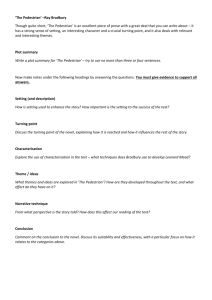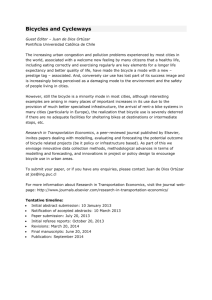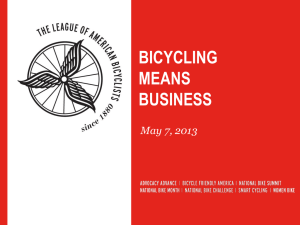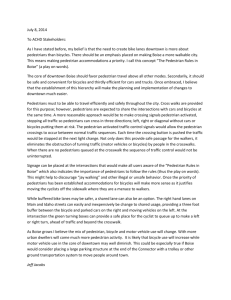Draft Memo #6 - Bicycle Pedestrian Plan
advertisement
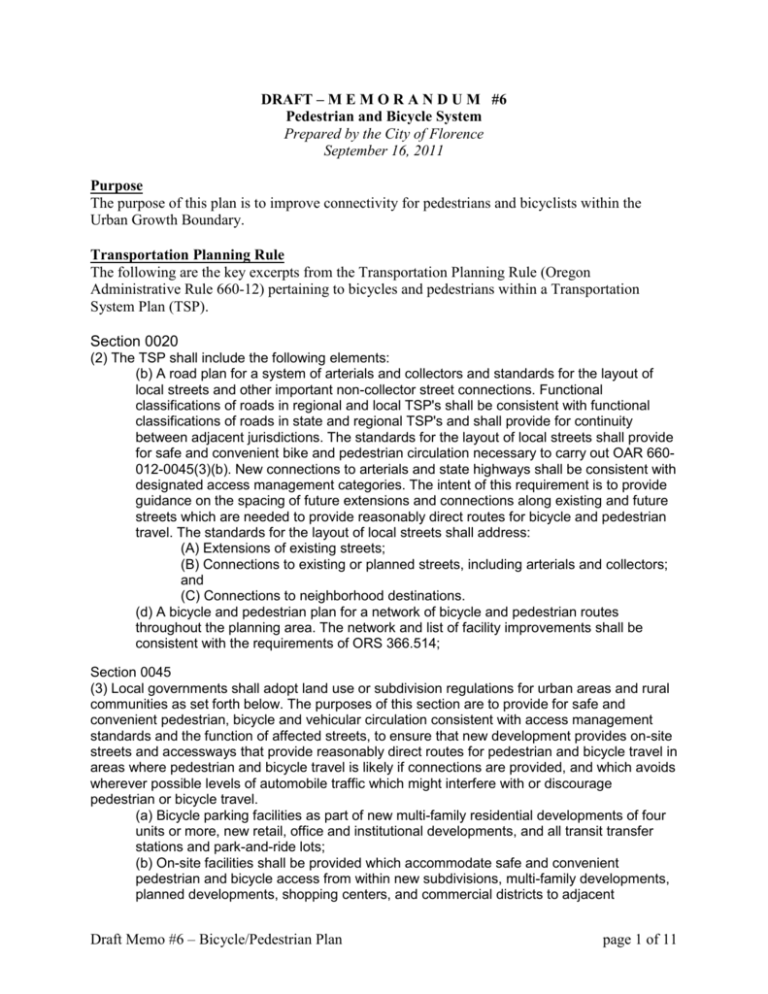
DRAFT – M E M O R A N D U M #6 Pedestrian and Bicycle System Prepared by the City of Florence September 16, 2011 Purpose The purpose of this plan is to improve connectivity for pedestrians and bicyclists within the Urban Growth Boundary. Transportation Planning Rule The following are the key excerpts from the Transportation Planning Rule (Oregon Administrative Rule 660-12) pertaining to bicycles and pedestrians within a Transportation System Plan (TSP). Section 0020 (2) The TSP shall include the following elements: (b) A road plan for a system of arterials and collectors and standards for the layout of local streets and other important non-collector street connections. Functional classifications of roads in regional and local TSP's shall be consistent with functional classifications of roads in state and regional TSP's and shall provide for continuity between adjacent jurisdictions. The standards for the layout of local streets shall provide for safe and convenient bike and pedestrian circulation necessary to carry out OAR 660012-0045(3)(b). New connections to arterials and state highways shall be consistent with designated access management categories. The intent of this requirement is to provide guidance on the spacing of future extensions and connections along existing and future streets which are needed to provide reasonably direct routes for bicycle and pedestrian travel. The standards for the layout of local streets shall address: (A) Extensions of existing streets; (B) Connections to existing or planned streets, including arterials and collectors; and (C) Connections to neighborhood destinations. (d) A bicycle and pedestrian plan for a network of bicycle and pedestrian routes throughout the planning area. The network and list of facility improvements shall be consistent with the requirements of ORS 366.514; Section 0045 (3) Local governments shall adopt land use or subdivision regulations for urban areas and rural communities as set forth below. The purposes of this section are to provide for safe and convenient pedestrian, bicycle and vehicular circulation consistent with access management standards and the function of affected streets, to ensure that new development provides on-site streets and accessways that provide reasonably direct routes for pedestrian and bicycle travel in areas where pedestrian and bicycle travel is likely if connections are provided, and which avoids wherever possible levels of automobile traffic which might interfere with or discourage pedestrian or bicycle travel. (a) Bicycle parking facilities as part of new multi-family residential developments of four units or more, new retail, office and institutional developments, and all transit transfer stations and park-and-ride lots; (b) On-site facilities shall be provided which accommodate safe and convenient pedestrian and bicycle access from within new subdivisions, multi-family developments, planned developments, shopping centers, and commercial districts to adjacent Draft Memo #6 – Bicycle/Pedestrian Plan page 1 of 11 residential areas and transit stops, and to neighborhood activity centers within one-half mile of the development. Single-family residential developments shall generally include streets and accessways. Pedestrian circulation through parking lots should generally be provided in the form of accessways. (6) In developing a bicycle and pedestrian circulation plan as required by 660-012-0020(2)(d), local governments shall identify improvements to facilitate bicycle and pedestrian trips to meet local travel needs in developed areas. Appropriate improvements should provide for more direct, convenient and safer bicycle or pedestrian travel within and between residential areas and neighborhood activity centers (i.e., schools, shopping, transit stops). Specific measures include, for example, constructing walkways between cul-de-sacs and adjacent roads, providing walkways between buildings, and providing direct access between adjacent uses. Parks and Recreation Policies, Recommendations and Projects In February 2011, the City adopted Comprehensive Plan policies and recommendations for Parks, Recreation and Open Space (Chapter 8). The City Council also acknowledged the Florence Parks and Recreation Master Plan. The following Comprehensive Plan policies and recommendations relate to bicycle and pedestrian travel and recreation in Florence. Parks and Recreation Policies 9. To provide a comprehensive trail plan that includes bicycle, pedestrian and boating facilities. 14. The City shall develop an interconnecting trail system, providing a full circular route around the Florence area and incorporating Rhododendron Drive, Munsel Lake, beaches, dunes, Old Town, Port and Siuslaw Estuary. The system shall also connect the various parks, residential areas, business, public places through the following actions: a. Consider the potential to establish or maintain bikeways and/or walkways prior to vacating any public easement or right-of-way;. b. Develop and adopt a Comprehensive Trail Plan that includes bicycle and pedestrian facilities and provides for park connections; c. Develop the bike lanes and multi-use paths identified in the Florence Transportation System Plan to connect bicyclists and pedestrians to parks, commercial centers and nature areas; d. Develop and adopt bike and pedestrian facility design standards; and e. Develop a system of trails and pathways to provide a safe network that links neighborhoods, parks, natural open space, schools, employment centers, shopping locations, recreation facilities and other key community destinations. 16. The City shall support Federal, State, County and City efforts to develop bicycle paths, such as the Oregon Coast Trail, connecting the City to nearby recreation areas. 19. The City, in conjunction with the Port of Siuslaw, Confederated Tribes of the Coos, Lower Umpqua, and Siuslaw Indians and the Siuslaw Watershed Council, shall plan and provide estuary and aquatic trails and put in and take out points along the Siuslaw River. 21. In pursuing funding for parks and recreational facility maintenance and enhancement, the City shall give priority to the following, not necessarily in this order: Draft Memo #6 – Bicycle/Pedestrian Plan page 2 of 11 c. e. f. 22. pedestrian, bicycle, and multi-use trail and path development; improved public access to existing public open space areas through public trails, signage and education in order to reconnect youth with nature and provide more close-to-home recreational opportunities that are free of cost, consistent with the State’s recreational planning priorities; acquisition of new park and open space areas in existing developed areas; (could be connectors) The City shall explore parks and open space funding through sources such as grants, systems development charges, use of a special levy, proceeds from street and right-ofway vacations, maintenance fees, and other available funding mechanisms. Where desirable, partnerships with federal, state, county and regional agencies, non-profit organizations, and private interests shall be formed to help secure and possibly finance land acquisition and facility development and redevelopment and maintenance of existing and proposed facilities. (moved from Chapter 11, Policy #2) Recommendations 4. The City should continue to apply for transportation enhancement funds, or other available funds to develop bicycle paths connecting the City to nearby recreation areas, particularly to: a. implement the Rhododendron Drive Integrated Transportation Plan; b. extend the Munsel Creek bike/pedestrian trail south to Gallagher Park and north to Munsel Lake; c. develop a bike/pedestrian system in the West 9th Street area; and d. improve linkages within the Oregon Coast Trail that connects the North Jetty area with the Oregon Dunes National Recreation Area. 5. The City should pursue establishment of an estuary trail connecting the Boardwalk with the Munsel Creek bike/pedestrian trail. ODOT has indicated a preference for an inculvert pedestrian crossing under Highway 126. Absent that opportunity they prefer a surface crossing be located midblock between Redwood and Spruce Streets. 8. In order to provide the public with increased and unrestricted access to the Siuslaw River and its estuary, the City should develop its public street rights-of-way which terminate at the River as river access parks, which may include parking to meet Old Town parking needs as appropriate. Definitions Bike Lane A separate lane adjacent to the vehicle travel lane for the exclusive use of bicyclists is a bike lane. Bike lanes are appropriate on arterials and collectors. Bike lanes must always be well marked to call attention to their use by bicyclists. Striped on-street bicycle lanes should be provided on all arterial and collectors streets in the following situations: collector streets that have daily volumes of more than 3,000 vehicles; where the collector street directly connects major residential areas with schools or parks; and where it may be necessary to ensure safe bicycle travel. Draft Memo #6 – Bicycle/Pedestrian Plan page 3 of 11 Multi-use Path (Shared-use Path) A facility separated from the roadway by an open space or barrier, either within the roadway right-of-way or within an independent right-of-way. They are typically used by pedestrians, joggers, skaters and bicyclists as two-way facilities. Multi-use paths are appropriate in corridors not well served by the street system (if there are few intersecting roadways), to create short cuts that link destination and origin points, and as elements of a community trail plan. Sharrows A street on which bicyclists and motorists ride in the same travel lanes (like shared roadways) but where markings and/or signage indicate the likely presence of bicycles. Shared Roadway Bicyclists and motorists ride in the same travel lanes. The shared roadway facility is best used where there is minimal vehicle traffic to conflict with bicycle traffic. Bicycle Projects Note: The Florence population includes an older demographic that want to maintain their independence but may not be able/comfortable driving a motor vehicle. For many, a motorized scooter is a good option. A transportation system designed for bicyclists also serves people who want to get around in motorized scooters. Heceta Beach Road Bike Lanes This street is currently a narrow 26-28 foot roadway with no shoulders. Heavy vegetation adjacent to the street provides a scenic “feel” to the traveler, and also makes widening difficult. A five-foot striped bike lane should be provided on both sides, resulting in a 34-foot wide cross section. From TSP Munsel Lake Road Bike Lanes Provide five foot bicycle lanes on both sides resulting in a 34-foot wide cross section. This bikepath provides an alternate connection of Highways 101/126 that avoids much of the developed section of Highway 101 within the City limits. Care must be taken to accommodate bicycles and pedestrians while maintaining scenic corridor feel. 4th Avenue Sharrows Although not listed in the text of the TSP, 4th Avenue is shown on Map 12I-1. This street would provide a connection from Heceta Beach Road and Rhododendron Drive north to the recreational opportunities on the land just north and east of the UGB owned by the US Forest Service and the Bureau of Land Management. With lower traffic volumes, the recommendation for accommodating bicycles on this street would be through Sharrows. Bike Route as Scenic Alternative to Highway 101 – for Coastal Bicyclists Heceta Beach Road to Rhododendron Drive to Kingwood to connect to OldTown. Kingwood Street Kingwood extends from 35th Street to 2nd Street. There are no bike lanes on Kingwood south of 10th Street. It is anticipated that this street will experience traffic volumes in excess of 3000 trips Draft Memo #6 – Bicycle/Pedestrian Plan page 4 of 11 per day by the year 2035. The right-of-way should be sufficient to provide for on-street parking on one side of the street. An alternative to bike lanes and one-side of curb-side parking is to keep on-street parking on both sides of the street and create Sharrows. Spruce Street South – Bike Lanes There are no bike lanes on Spruce south of 25th Street. This street is an important north-south route east of Highway 101. There are few homes fronting on Spruce Street, so there is little need for on-street parking and bike lanes could be added relatively easily. Spruce Street North - Sharrows There are no bike lanes on Spruce Street between 37th and 42nd, but this street is used as a major bike connection as both 35th and 42nd Streets have bicycle lanes. However, on this segment of Spruce Street, there are several homes fronting on Spruce. The traffic in this location is a little lower than that on the southern part of Spruce, so Sharrows would be a good solution. Oak Street Bike Lanes There are no bike lanes on Oak Street south of 24th Street. In order to provide safe bicycling to the elementary school, bike lanes should be provided. Quince Street Bike Lanes/2nd Street Sharrows Quince Street is currently wide enough to strip bike lanes. These should be striped from Highway 101 down to Harbor Street. At that point, travel speeds into Old Town are lower and traffic begins to disperse. From Harbor Street to Highway 101, bicycles could be accommodated with Sharrows in order to continue to provide on-street parking. 9th Street Sharrows Most of 9th Street has bicycle lanes, but the portion just west of Highway 101 does not due to a turn lane. For this section, the travel lanes should become Sharrows. Highway 101 Bike Lanes between Bridge and Hwy. 126 Currently, there are no bicycle lanes along the section of Hwy 101 between the 126/101 intersection and the Bridge. There is not enough right-of-way to accommodate standard bicycle lanes and on-street parking. Even if ODOT striped a reduced 11' outside lane width it would not provide the 14' needed for a standard 6' bike lane and 8' on street parking. One way to provide bike lanes is to do a “road diet” where all the lanes are narrower than the standard. ODOT would have to agree to the exceptions needed to the standard median, travel lane, bike lane and parking widths to narrow them all up and be very close to fitting all of them in. If the Highway Engineer approved the reduced widths it would require a full paving overlay project because the existing durable striping would need to be ground off to change the configuration. Otherwise, eliminating on-street parking would be necessary to provide bike lanes. A third option would be Sharrows. Draft Memo #6 – Bicycle/Pedestrian Plan page 5 of 11 Bicycle Programs Regular Street Sweeping of Highway 101 Each year, especially in the summer, many bicyclists ride through Florence as they ride the Oregon Coast. When there is an accumulation of debris within the bicycle lanes, it becomes unpleasant and sometimes dangerous for bicyclists. Regular street sweeping would keep these bicycle lanes clear. In addition to the sweeping the streets, ODOT could post a schedule of street-sweeping. Regular Enforcement of “No Parking in Bicycle Lanes” Regular enforcement of this requirement would ensure that the bicycle lanes are not blocked by parked vehicles that create a safety hazard for bicyclists. Problem areas identified are: 27th Street during football games; Spruce Street between 35th and 37th, and 42th Street. Bicycle Parking The City currently requires the provision of bicycle parking as part of new development. The City could look at requiring or at least encouraging bicycle parking when new businesses go into existing buildings. The City could also institute a program of educating and encouraging existing businesses that are not already providing bicycle parking to do so. Perhaps this project could be performed in conjunction with the Chamber of Commerce as a way to create a more inviting community to the local bicycle community as well as all the bicyclists travelling through as they ride to or along the Oregon Coast. Become a Bicycle-Friendly Community Work toward becoming a “Bicycle-Friendly Community.” The Bicycle Friendly Community Program (BFC) provides incentives, hands-on assistance, and award recognition for communities that actively support bicycling. A Bicycle Friendly Community welcomes cyclists by providing safe accommodation for cycling and encouraging people to bike for transportation and recreation. http://www.bikeleague.org/programs/bicyclefriendlyamerica/communities/ Bicycle Map Create a map (available on paper and electronically) showing the designated bicycle routes through town (roads with bicycle lanes, shared-use paths, sharrows) with mileage indications. It could include traffic safety cautions as an educational opportunity. This map could feature tourist locations, bicycle-friendly shopping opportunities, parks and recreation sites, and/or scenic spots. It could also include business sponsorships/advertisements to pay for the printing. See Newport’s Bike Map as an example. Partner with Port to Promote Bicycle Camping If some of the thousands of bicyclists that ride the Oregon Coast knew about camping opportunities at the Port, some may chose to overnight in Florence where they would have ready access to dining, shopping, and recreation opportunities in Old Town. Educate Bicyclists about Rules of the Road Provide information about state law (see “Pedal Power – a Legal Guide for Oregon Bicyclists” at http://www.stc-law.com/pdf/PP7thEdition.pdf) as well as the City Code (Title 7 Chapter 1 Traffic Regulations, Section 4 General Driving Regulations). Draft Memo #6 – Bicycle/Pedestrian Plan page 6 of 11 Bike to Work/School Promotion Partner with Peace Health to promote Bike to Work/School month, week, day to promote bicycling and walking as a convenient, healthy, safe, and viable transportation modes. Replace Dangerous Storm Drains Some storm drains are installed such that bicycle tires can get caught in them, a safety hazard. These storm drains should be replace with drains that have cross-members going in opposite direction of bicycle tire with no gaps between pavement and metal grate. Bicycle/Pedestrian Projects Rhododendron Drive Recognizing the scenic value of this key transportation corridor, the City adopted the Rhododendron Drive Integrated Transportation Plan after extensive public involvement. This Plan divides Rhododendron Drive into segments as well as identifying several viewing waysides. In summary the Plan indicates the following improvements for bicycles and pedestrians within these segments: Highway 101 to Hemlock – sidewalks and bike lanes both sides with parking on one side Hemlock to 9th Street – bike lanes and sidewalks on both sides (no on-street parking) (Due to limited development on southeast side, sidewalks may not be necessary on both sides of the street for this segment) th 9 to 12th – transition segment – sidewalk on west side, bike lanes both sides, and wider path separated from road on east side 12th to City limits – pedestrians and bicyclists share path on east side of Rhododendron Phil Farrington of Peace Health submitted comments on this plan, see attached letter dated July 30, 2010. Munsel Creek Path This shared-use path is developed between Quince Street on the south and 25th Street on the north. Between 16th and 25th Streets, the path follows Willow Loop and 23rd Street to connect to the stream corridor on Willow Street. It currently needs an overlay or to be repaved. Ultimately, it will connect across Highway 126 to the Estuary Trail. There should be more access points to this path, including a connection with Gallagher Park. The Munsel Lake Boat Launch and Lake Access Area on Munsel Lake Road is a logical destination for water habitat and related trails. The path is proposed to extend from its termination point west of the City wellfields through City lands to City owned overlook over the Florentine Estates wetland and then east across City land to the service road for the wellsites north of City lands. The last section from the service road to Munsel Lake Road will require dedication and development of shared-use path right-of-way and/or easements as the owner develops his property for residential uses. Estuary Trail Connect Boardwalk in Old Town to south end of Munsel Creek Path. (The Siuslaw Estuary Partnership is currently working on Recommended Trail Designs and Location Options. Draft Memo #6 – Bicycle/Pedestrian Plan page 7 of 11 12th Street Path This path between Kingwood and Rhododendron was recently developed into a bark path. The next stage is to cross the wetlands and then to pave the entire path. 12th Street Connection between Munsel Creek Path and Highway 101 There is existing right-of-way that is undeveloped but would be a good location for a multi-use path between the Munsel Creek Path and Highway 101, south of the old Rite Aid store. Oak Street between 15th and 10th This segment of existing right-of-way is not likely to be developed as a full street due to the topography and location of existing house that will prevent the necessary regarding to achieve necessary slopes. However, paving a path from 15th to 10th would provide a continuous bicycle/pedestrian connection from 46th Street to Downtown. Pedestrian Projects Pedestrian Access to Siuslaw River Bridge Add sidewalks along Highway 101 north of the Siuslaw River Bridge to connect to existing sidewalks that begin around 2nd Street. Also restore western stairs from Bay Street to Highway 101 Bridge over Siuslaw and construct interpretive overlook at northeast location of bridge. Fill in Missing Sidewalk Segments within OldTown Old Town is one of the primary tourist areas within Florence developed with vibrant retail stores, quality restaurants, views of the Siuslaw Estuary and Historic Bridge, the Boardwalk, and the Port’s docks and marina. This part of town is developed to a pedestrian scale with historic lighting. However, there are some segments without sidewalks that discourage walking or else result in people walking in the street. New and reconstructed sidewalks are to be a minimum of eight feet wide in Old Town Area A and a minimum of eight feet wide along Quince/2nd Street. Quince/2nd Street is the main connector between Highway 126 with Old Town. In addition to wide sidewalks, plantings and street trees are desirable to create a greenway effect. 12th Street Crossing of Highway 101 With a planned path within the 12th Street right-of-way between the Munsel Creek Path and Highway, a good location for a safe crossing of Highway 101 is at 12th Street. This crossing is identified with potential design shown in the U.S. 101 Pedestrian Study by Alta and CHSMHill. Branch Engineering has developed plans for a pedestrian crossing (see attached designs). To provide for safe pedestrian connection to crossing, there is also a sidewalk needed on the south side of 12th Street on the west side of Highway 101. 15th/16th Mid-Block Crossing Branch Engineering also has 60% plans completed for this intersection (see attached designs). 27th Street Crossing The current TSP includes a traffic signal on Highway 101 at 30th Street. ODOT and the City of Florence constructed a pedestrian crossing at 30th. Part of this TSP update includes consideration of relocating the traffic signal back to 27th Street. If that does not happen, then a safe pedestrian crossing should be provided at 27th per the Alta Plan (p. 33). The multi-use path within 27th Draft Memo #6 – Bicycle/Pedestrian Plan page 8 of 11 Street right-of-way has already been constructed. There would need to be a new sidewalk on the south side of 27th Street to connect to existing sidewalks on Oak Street and provide a safer connection for pedestrians. 43rd Street Crossing and/or in Front of Fred Meyer The Alta Study includes a pedestrian crossing at 43rd Street. As Cannery Station was approved on the east side of Highway 101, it was then thought that a pedestrian crossing should be built between that development and Fred Meyer. The timing and priority of these pedestrian crossings will be based on actual development. Pedestrian Crossing of Highway 126 A pedestrian activated crossing similar to the others constructed in town is needed for Highway 126 if the Estuary Trail ends up with a surface crossing of Highway 126. This crossing would be somewhere between Quince and Spruce Street, perhaps at Redwood. Pedestrian Crossing at 9th and Kingwood This intersection is problematic for motorists as well as pedestrians. It is on a primary emergency corridor and has been identified as an issue for bus drivers. A pedestrian signal and crosswalk should be added to any redesign of this intersection. Pedestrian Crossing Study Now that the City and ODOT have installed four pedestrian crossings on Highway 101 (2nd Street, 7th/8th Street, 17th/18th Street, and 30th Street) it would be useful to determine if these pedestrian-activated crossings have altered people’s habits in terms of crossing Highway 101. This study should include pedestrian counts at various intersections. With this additional information, the City could determine if additional locations are needed and how best to prioritize those needs. It has been noted that lots of kids coming from the 23rd/24th Street area and crossing in front of the former Dunham Motors and south of the Taco Bell during the lunch hour. So there may be a need for a crossing between 21st and 27th Streets. Crosswalks on Maple and Kingwood Safe Routes to School A priority for providing safe pedestrian access to the schools in Florence include: 1 – Construction of sidewalks along the east side of Oak Street from 27th Street to 32nd Street 2 – Crosswalks at the 27th and Oak Street intersection. 3 – Crosswalks at the 30th and Oak Street intersection. 4 – Crosswalk across Oak Street in line with the pedestrian path between Oak Street and Myrtle Loop (just south of 34th Street) 5 – Crosswalk at 35th and Oak Street intersection. Sidewalks along all Arterials and Collectors Of all the streets in the UGB, arterial and collector streets have the most traffic and vehicles travelling at higher speeds than local streets. As such, these types of streets need to accommodate pedestrians on sidewalks or multi-use paths. They also should allow for safe crossings through improvement such as crosswalks, pedestrian activated crossings, medians, curb-extensions. Where development occurs adjacent to these streets, sidewalks should be Draft Memo #6 – Bicycle/Pedestrian Plan page 9 of 11 required as part of development approval (or if immediate construction is impractical, have a commitment for construction in the form of a non-remonstrance agreement). However, in other cases where adjacent land uses are already developed, the State/City/County may need to create projects with identified funding sources in order to construct sidewalks. These projects could be funded through Local Improvement Districts, grants, and/or system development charges. The following arterials and collectors have been identified through this planning process as being the most critical: Kingwood Street With Kingwood a major north-south Street and expected traffic volumes exceeding 3000 trips per day by the year 2035, sidewalks are necessary for safe walking. Futhermore, Kingwood provides connections to the Senior Center, Singing Pines, the Airport, the 12th Street Path, Downtown. There is also a school bus stop between 9th and 10th. This project would construct sidewalks from approximately 20th Street south. Highway 101 All areas along Highway should have sidewalks to provide safe pedestrian travel and access to adjacent businesses. Munsel Lake Road There are no sidewalks on Munsel Lake Road, a county road. It is projected to have traffic volumes exceeding 3000 trips per day by the year 2035. Part of the street is inside the City and part of it is outside the City. There is residential development around Ocean Dunes that in particular should be provided with sidewalks to provide access to the Morman Church, Munsel Road Park, and Ocean Dunes Golf Course. Pedestrian Access to Parks There are various parks in town that lack sidewalks. These include: Singing Pines Park – construct sidewalks along Airport/15th Street and Kingwood Street Miller to Singing Pines – pave the path between these two parks 29th Street Path – reconstruct this path from Spruce Street to Munsel Greenway Park. This path needs to be regarded to allow for redesign of the barrier along Spruce Street. Include signage for path indicating access to Munsel Greenway Park. Pedestrian Programs Code Requirements and Enforcement to Ensure Safe, Passable Sidewalks (from Alta Study) 1 – Require landscape material such as large bark chips and rocks be secured or kept away from the sidewalk. If landscaping rocks or chips blow or roll onto the sidewalk, they can become a trip hazard or an impediment to wheel chairs. 2 – Keep shrubs and other landscaping trimmed to prevent encroachment onto/over sidewalk and to maintain vision clearance areas. 3 – Where parking lots are adjacent to sidewalks, require curbs or wheelstops to keep the vehicles from overhanging the sidewalk. Draft Memo #6 – Bicycle/Pedestrian Plan page 10 of 11 4 – Request ODOT install Leading Pedestrian Interval (LPI) signals at all signal controlled intersections. These LPI signals provide the pedestrian a three- to four-second head start to begin crossing the intersection prior to release of turning vehicles. With the demographics of Florence weighted heavily towards those 55 and older, the additional crossing time provided by LPI would improve pedestrian safety and comfort. Walking Map Create a map (available on paper and electronically) showing safe walking routes indicating mileage. The map could include traffic safety reminders. These could include walks to scenic vistas, parks and recreation opportunities, points of interest, and/or shopping opportunities. It could also include business sponsorships/advertisements to pay for the printing. Educate Pedestrians about Rules of the Road Provide information about state law (see “Oregon Pedestrian Rights – A Legal Guide for Persons on Foot” at http://www.stc-law.com/pdf/OPRlegal_guide.pdf) as well as the City Code (Title 7 Chapter 1 Traffic Regulations, Section 8 Pedestrians). This project is partially funded by a grant from the Transportation and Growth Management (TGM) Program, a joint program of the Oregon Department of Transportation and the Oregon Department of Land Conservation and Development. This TGM grant is financed, in part, by federal Safe, Accountable, Flexible, Efficient Transportation Equity Act: A Legacy for Users (SAFETEA-LU), local government, and State of Oregon funds. The contents of this document do not necessarily reflect views or policies of the State of Oregon. Draft Memo #6 – Bicycle/Pedestrian Plan page 11 of 11
